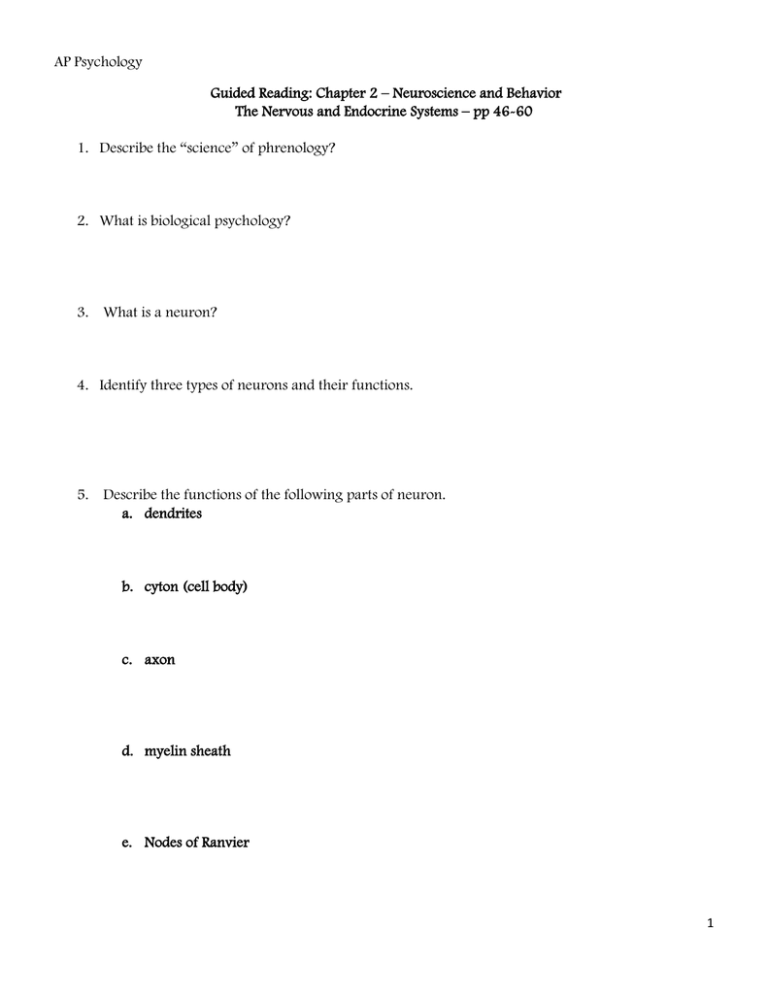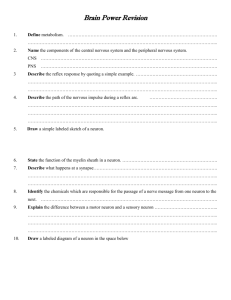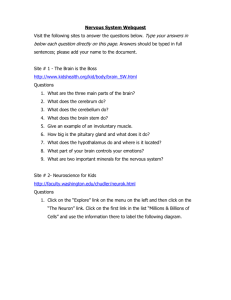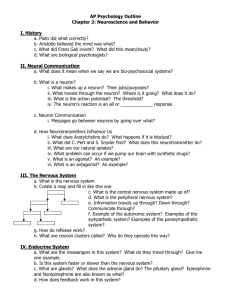File - Ms. G's Classroom
advertisement

AP Psychology Guided Reading: Chapter 2 – Neuroscience and Behavior The Nervous and Endocrine Systems – pp 46-60 1. Describe the “science” of phrenology? 2. What is biological psychology? 3. What is a neuron? 4. Identify three types of neurons and their functions. 5. Describe the functions of the following parts of neuron. a. dendrites b. cyton (cell body) c. axon d. myelin sheath e. Nodes of Ranvier 1 f. Schwann Cells g. terminal branches h. terminal buttons 6. Using arrows to point to each part, correctly label the parts of the neuron listed above in the diagram below: 2 7. What is an impulse? 8. In what direction does an impulse travel along a neuron? 9. What does it mean when a neuron is in a state of resting potential? 10. How are the electrical charges arranged in a resting neuron? 11. Where are the sodium (Na+) and calcium (Ca+) ions located in a resting neuron? 12. What is the overall charge of a polarized neuron (resting neuron)? 13. What is meant by the term threshold? 14. Define the term action potential. 15. What is the voltage needed to meet threshold and set off an action potential? 16. Define the term depolarization. 3 17. Describe depolarization with respect to charge and accumulation of Ca+ & Na+ inside/outside the neuronal axon. 18. How does depolarization help the impulse to move down the axon? 19. Define the term repolarization. 20. Describe what happens during the repolarization. 21. What is refractory period of a neuron? 22. Define saltatory conduction AND explain how it helps speed impulse transmission down an axon. 23. Differentiate between excitatory and inhibitory impulses. 24. What determines if a neuron fires (or not)? 25. Describe the all or none firing response of a neuron. 26. How is intensity of a stimulus conveyed to the brain? 4 27. Where are terminal buttons found? 28. What is a synapse? 29. Define the term neurotransmitter. 30. Where are the neurotransmitters manufactured? 31. How is an impulse carried across the synapse? 32. Describe the process of reuptake? 33. How do chemical antagonists affect neurotransmitters? Provide one example. 34. How do chemical agonists affect neurotransmitters? Provide one example. 5 35. Summarize the information that is found in the chart in your PP. This is your study guide to learning these neurotransmitters, their functions, and results of deficits & surpluses in the human body. Neurotransmitter Function Deficit Surplus Acetylcholine (Ach) Dopamine Serotonin GABA Epinephrine Endorphins Glutamate 36. Differentiate between the central and peripheral nervous systems. 37. Discuss the functions of the peripheral nervous system. 38. Compare the somatic and autonomic nervous systems. 6 39. Describe functions of the sympathetic nervous system. 40. Alternately, describe the functions of the parasympathetic nervous system. 41. Based on what you know about the nervous system, explain why people say you should not go swimming right after you eat a meal. 42. What is the function of the meninges? 43. How is the spinal cord protected from injury? 44. What type of cells make up the spinal cord and brain? 45. Where are glial cells found? 7 46. List the functions of glial cells. 47. Describe the function of the spinal cord. 48. What is an effector AND provide two examples in the human body. 49. What is a reflex? Provide an example. 50. Define the terms afferent and efferent. 51. You touch a hot stove – describe the pathway AND your responses the impulse takes as it travels from your finger to your brain (remember this is a reflex arc!) 52. List the functions of glial cells. 53. What is a neural network and how does it help the brain to learn? 8 54. Describe the functions of the endocrine system. 55. What are hormones? 56. Compare the nervous and endocrine systems (both similarities and differences). 57. How are hormones transported from the glands where they are secreted to their targeted cells? 58. Describe the function of the hypothalamus with respect to the endocrine system. 59. Why is the pituitary gland called the master gland of the endocrine system? 60. Describe the function of each of the hormones produced by the pituitary gland: a. TSH (thyroid stimulating hormone) b. FSH (follicle stimulating hormone) c. LH (luteinizing hormone) d. GH (growth hormone) 9 e. ADH (antidiuretic hormone – vasopressin) f. ACTH (adrenocorticotrophic hormone) 61. Describe the location and the structure of the thyroid gland. 62. Indicate the function of thyroxin 63. What is goiter? 64. Differentiate the symptoms that result from an overactive or underactive thyroid. (include physical and psychological). 65. Where are the parathyroid glands located? 66. Describe the function of parathormone? 67. Where are the adrenal glands located? 68. Describe the function of epinephrine (adrenalin)? 10 69. Where are glucocorticoids produced? 70. Describe the function of glucocorticoids. 71. Differentiate between insulin and glucagon (produced by the pancreas). 72. Describe the functions of estrogen. 73. Discuss the functions of testosterone. 11







